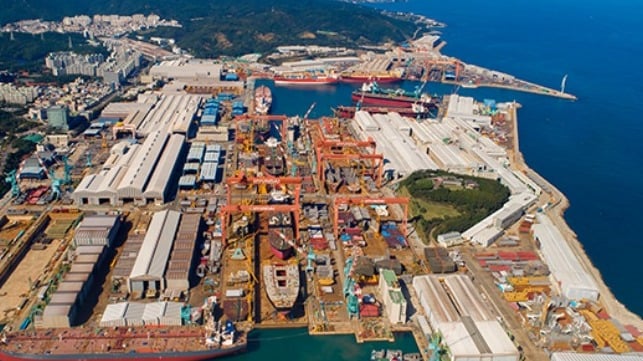BIMCO: Strong Rebound for Shipbuilding Orders in Five Months of 2021

The shipbuilding industry is experiencing a resurgence in orders in the first months of 2021 driven by market demand especially in container shipping. A new analysis from the industry trade group BIMCO reports that orders for new containerships doubled so far in 2021 nearly reaching the total tonnage ordered for all of 2021. The orders for new VLCCs are also outpacing the market while dry bulk has lagged.
“The vast amount of money pouring into container shipping is finding its way into the shipyards, with the current tightness in the supply of ships incentivizing some owners to expand their fleets,” says BIMCO’s Chief Shipping Analyst, Peter Sand. “Although also making good money in the current market, dry bulk owners have been more reluctant to order new tonnage, with the second-hand market proving more popular.”
Total orders for the three largest segments of commercial shipping, containerships, tankers, and dry bulk, increased nearly 120 percent in the first five months of 2021 versus 2020 when shipowners were reluctant to place orders at the onset of the pandemic.
So far in 2021, BIMCO reports that orders totaling 43.6 million dwt have been placed at shipyards. That compares with 19.8 million in the first five months of 2020. In all of 2020, 49 million dwt was ordered, with the current pace of orders only 11 percent behind the total for all of last year. As would be expected, the three largest shipbuilding nations, China, South Korea, and Japan, have received the orders.
It has been a truly record-breaking start to the year for containership orders, says BIMCO. They tally that a total of capacity of 2.2 million TEU has been ordered so far in 2021. This is more than 12 times higher than the 184,254 TEU ordered in the first five months of 2020 and more than 60 percent higher than the previous record, which dates back to the start of 2005.
The most popular ship type, measured in TEU as well as the number of ships, has been Ultra Large Container Ships (ULCS) which have a capacity of 15,000 TEU or higher. A total of 89 vessels have been ordered in this category with an average capacity of 16,622 TEU. BIMCO, however, highlights that no containerships between 16,000 and 23,000 TEU have been ordered.
Containership demand is polarized to between 15,000 and 16,000 TEU ships on one side and 24,000 TEU ships on the other. There are 14 orders for what will be the largest containerships in the world, each exceeding 24,000 TEU. However, the majority of the orders have been 15,000 to 16,000 TEU ships. A total of 75 ships with a combined capacity of 1.1 million TEU was ordered in what is now a mid-sized category.
“The biggest of the ULCS are proving less popular with carriers seeing the 15-16,000 TEU ships as a better option,” says Sand. “This is because they still offer solid savings from economies of scale while not putting the same limits on flexibility as the 20,000+ TEU ships have in terms of trading patterns.”
The vast majority of the tonnage ordered so far this year will be delivered in 2023, which according to BIMCO estimates will see 1.5 million TEU delivered. This would make it the busiest year for container ship deliveries since 2015.
Although not matching the staggering growth in container ship orders, demand for new crude oil tankers has been strong, up 47.4 percent over the first five months in 2020. Oil product tankers on the other hand have seen a fall in new orders, whereas dry bulk contracting, despite the strong freight and S&P markets, is only slightly above last year’s level.
“The tanker market is split in two. We are seeing a rise in contracting for crude oil tankers, as owners who filled their coffers during the height of the market last year are betting on a better market when the ships are delivered, whereas oil product tankers are proving less popular,” Sand says.
Despite weaker market conditions in the first five months of this year compared with the start of 2020, ordering of VLCCs has risen 125 percent to a total of 8.2 million dwt, up from 12 ships to 27. After just five months, VLCC ordering is now only 4 ships (1.1 million dwt) shy of total ordering in 2020. The rise in VLCC contracting has been enough to make up for the fall in the contracting of smaller crude oil tankers. Ordering of Aframax and Suezmax tankers has fallen 44.5 percent to 1.5 million dwt between January and May 2021 compared to 2020.
In contrast, in the oil product tanker market, the bigger long-range ships have proven less popular than MR tankers, of which 28 have been ordered totaling 1.4 million dwt. The orders are all with a capacity of 40-50,000 DWT. For LR2 tankers, only five orders have been placed so far this year, and none for LR1 tankers.
The bigger ships are also the most popular in the dry bulk market. Contracting for Panamax and Capesize ships has risen by 40.9 percent, while a 56.5 percent fall in new orders for Handysize and Handymax ships means total dry bulk contracting activity has risen by only 3.6 percent to 8.6 million dwt.
Other segments of the shipping building industry are also not enjoying the strong rebound in new orders. While BIMCO does not track the cruise ships, that segment, which had one of the largest orderbooks, is currently stagnant. Only one new cruise ship was ordered in 2021. NYK ordered a 51,950 gross ton cruise ship due for delivery by the end of 2025 from Meyer Werft, but the shipbuilders were able to preserve the pre-pandemic orders and are proceeding to deliver those cruise ship new builds.
